From cover to career – a look at Amiga coverdisk applications
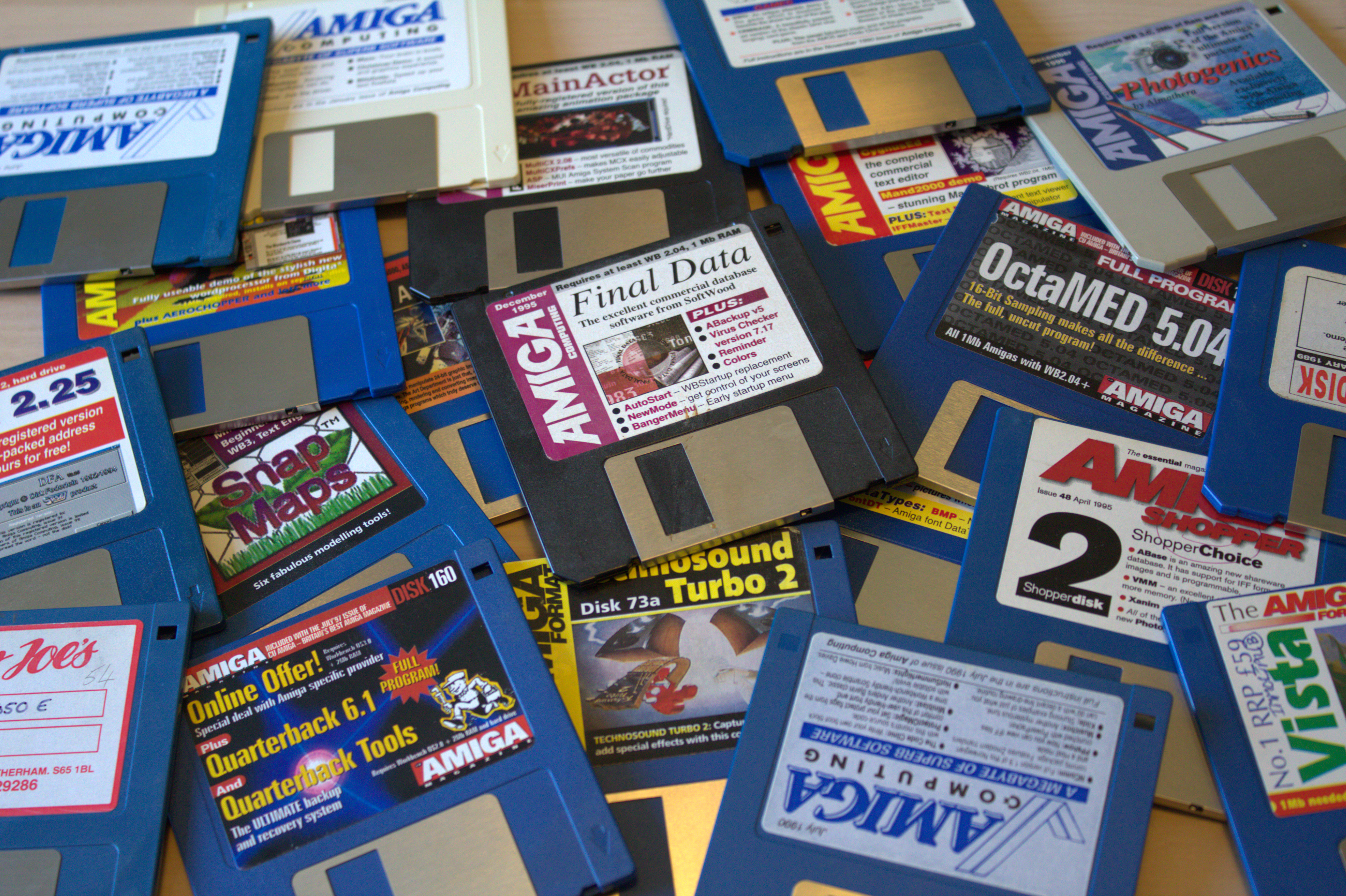
Back in the heyday of the Amiga, most people’s only contact with the wider world of the format was via magazines. Save for the odd rumour from your mates, there was no other source for the latest information about your favourite platform, unless you were one of the lucky few with a modem or access to a user group. In the UK, at one point in time, we had seven concurrent magazines of varying quality, giving everyone – from the casual fan to the most hardened enthusiast – plenty to read on every subject from games to applications to hardware. We all had our favourite publications, of course, and we read them cover to cover, regardless of our interest in any particular subject. But I think few people can disagree that what often drew us to pick up a particular magazine over another was frequently the small squares of plastic on the front – the coverdisks.
Magazines helped us enjoy the Amiga that little bit more, and enabled us to discover amazing games we just wouldn’t have picked up otherwise. But there’s another aspect to coverdisks, the importance of which often gets overlooked. The free applications.
Games weren’t necessarily cheap in the 80s and 90s – full price games could run you £20+, which was a lot for a teenager without a steady income. But that pales into insignificance when you look at applications. These could easily run into the hundreds of pounds, and would be completely inaccessible for most users. With many of those users just getting their start in computing, access to a quality piece of productivity software could quite literally have life-changing consequences for the average Amiga user, and perhaps set the course of a future hobby or even career. I think I bought maybe one or two applications in my whole Amiga-owning life. But, as the kind of person that likes to dip their toe into many creative pools, this wouldn’t have been enough for me, and would have severely curtailed my experience with everybody’s favourite 16-bit system.
Magazines to the rescue! Pretty much every kind of application you can conceive of was given away free of charge on an Amiga magazine at one point or another. Some were obviously demos, but many were either fully featured products, or had just a few features turned off. In most cases, the publishers gave old versions of products to magazines on the proviso that they would get a feature or short article about the latest version – the version people could pay cold hard cash for, to get that hot new feature. For us users, the covermount application was like getting a second-hand car – it wasn’t quite the shiny new model, but it could definitely get you from A to B…
So let’s take a look back at just what applications turned up on UK magazines back in the day. I’ve dug into some of the biggest magazines – Amiga Format, CU Amiga, Amiga Computing – and tried to pull out some of the applications that were a real steal. And if you look around the article, you’ll also see some examples of how these applications went on to change people’s lives. Let’s get started.
Art
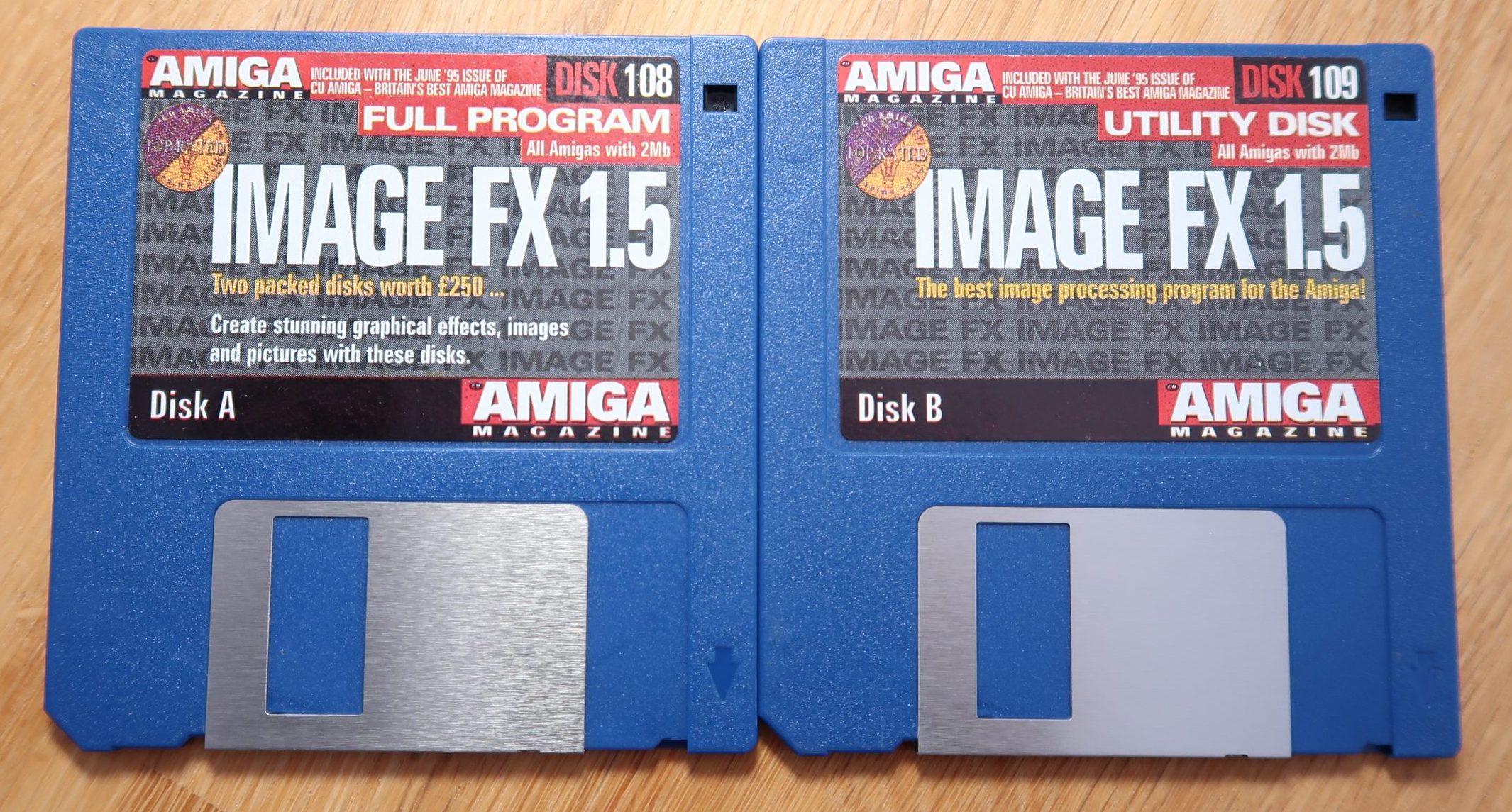 The Amiga is well known as a creative machine – graphics and art are one of its fortés. And while a full version of Deluxe Paint never made its way onto a coverdisk (although there were demos), there was no shortage of artistic software packages being made available – for free – to lucky readers.
The Amiga is well known as a creative machine – graphics and art are one of its fortés. And while a full version of Deluxe Paint never made its way onto a coverdisk (although there were demos), there was no shortage of artistic software packages being made available – for free – to lucky readers.
Those looking to get to grips with pixel art had the more than capable Personal Paint to get to grips with, with v4 being given away in full with Issue 89 of Amiga Computing. Budding pixel artists could also get v6.4 and v7.0 with Issues 96 and 110 of Amiga Format, although this was maybe a little too late in the Amiga’s lifecycle for most.
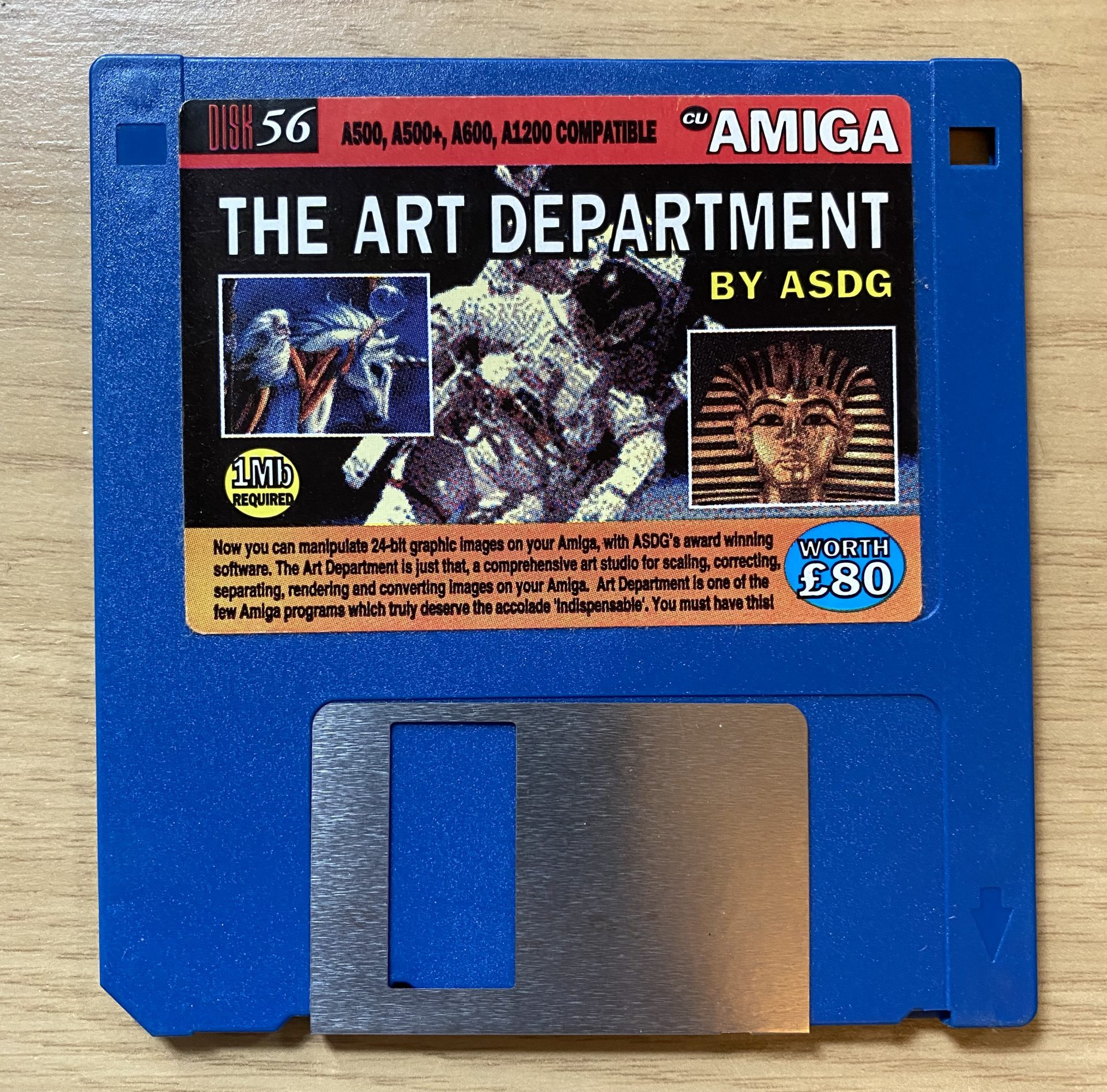 The Amiga isn’t just good at creating art from scratch – it also features a bunch of advanced image processing packages to tweak your images to perfection. One of the most famous is The Art Department (and its “professional” follow-up), which was given away on the cover of CU Amiga May 93, with the magazine offering a discount on a full manual and an upgrade to ADPro. The June 95 edition of CU offered more image processing goodness with Image FX 1.5, while AF69 and AC106 both gave away copies of the powerful image manipulation tool Photogenics. You can still do great work on images with these packages, even today.
The Amiga isn’t just good at creating art from scratch – it also features a bunch of advanced image processing packages to tweak your images to perfection. One of the most famous is The Art Department (and its “professional” follow-up), which was given away on the cover of CU Amiga May 93, with the magazine offering a discount on a full manual and an upgrade to ADPro. The June 95 edition of CU offered more image processing goodness with Image FX 1.5, while AF69 and AC106 both gave away copies of the powerful image manipulation tool Photogenics. You can still do great work on images with these packages, even today.
Maybe moving pictures are more your scene? CU Amiga had you covered – in September 1992 they offered Gold Disk Inc.’s MovieSetter package to create your own animated movie… and then in December 1993, they offered the fully featured Aegis Animator on their front cover.
To round things off – literally in this case – Amiga Format had a covermount of ProVector 2.1 on Issue 58. This is a structured drawing package, so unlike DPaint, you’re working with vectors, lines and curves to create a mathematically described image that can be scaled to your heart’s content. Certainly a cool piece of software to have in your toolkit if you wanted to get into, say, publishing your own magazine…
ImageFX 1.5 on a (I think) CU Amiga coverdisk got me well and truly hooked on digital photo manipulation (aka ‘photoshopping’), encouraged me to buy the full updated package a few years later, and to continue messing around with images in a variety of PC apps over the 20-odd years since then. Still only a hobby for me, though it’s a skill that occasionally comes in handy when tweaking photos for some in-house product documentation I’m writing. [Chris Coulson]
3D Modelling
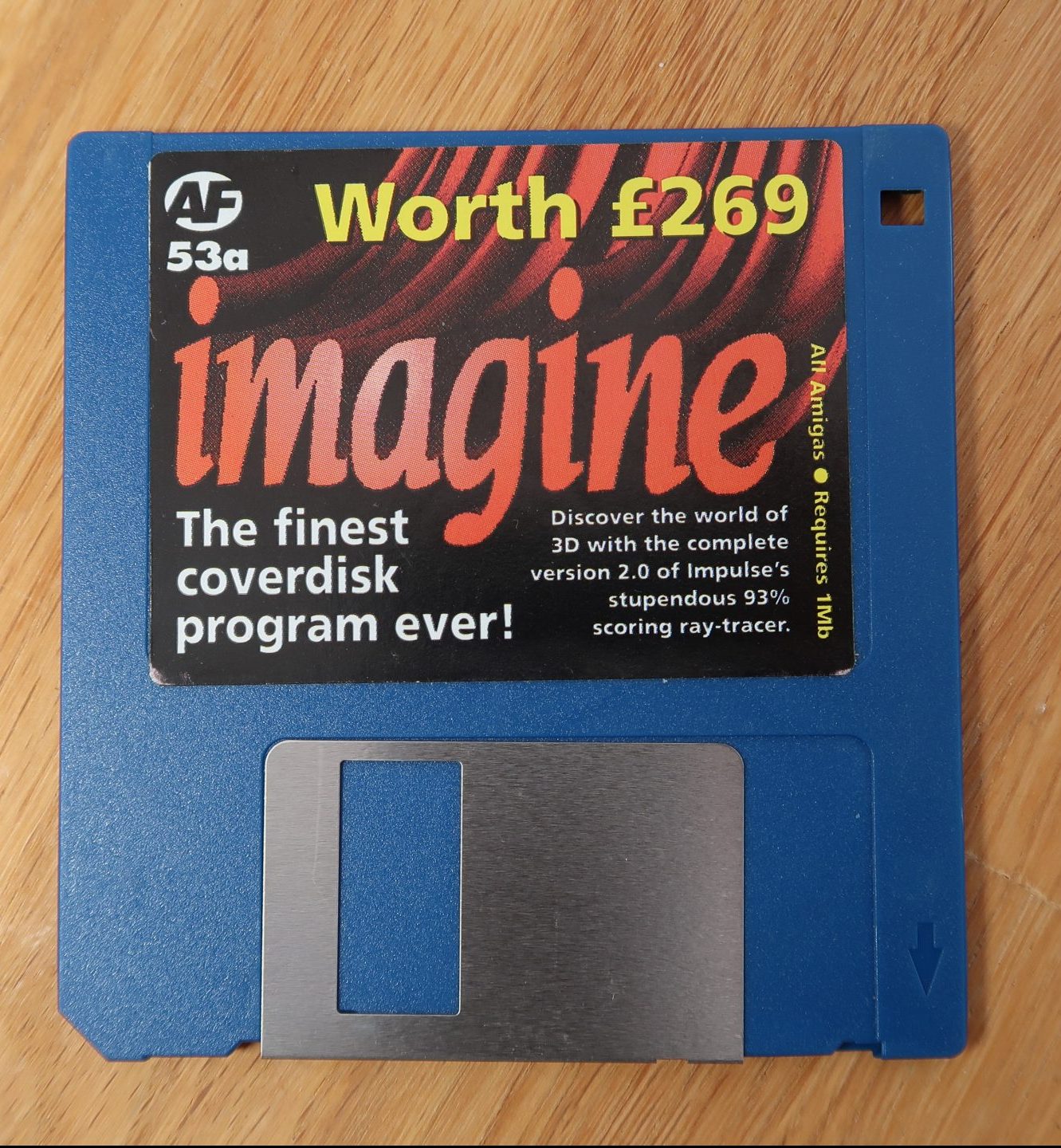
A step up from pixel art and photo manipulation, the third dimension offers something completely new to the artist. In an era when most games were 2D, 3D modelling was something shiny and new to pretty much everyone who encountered it. Of course, most Amigas struggled for the raw power required to render their creations, but those with enough patience could be richly rewarded.
Many different 3D package developers hawked their wares through the medium of the magazine floppy. You can’t go far wrong with Imagine, of course, and version 2.0 of the 3D software with the golden interface was on the cover of AF53, with versions 3.0 and 4.0 turning up on CU Jan 96 and Jan 97.
Most of these application coverdisks were supported by short tutorials in the magazine, and some even came with a small custom printed book taped to the magazine cover. Such was the case with Real 3D, free with AF77 (a previous version came with AC40). After a short bit of reading in the magazine, you would soon be well on your way to modelling your first blue teapot, or, if you were me, a sphere with no lighting, so you just got a plain black screen after hours of wasted rendering!
To complete this trio of revered renderers, AF92 gave away Cinema 4D 2, a notable package whose latest revision was released just last year, and whose 30 year pedigree extends to use in films like Tron: Legacy, Pacific Rim and Avengers: Endgame.
Music
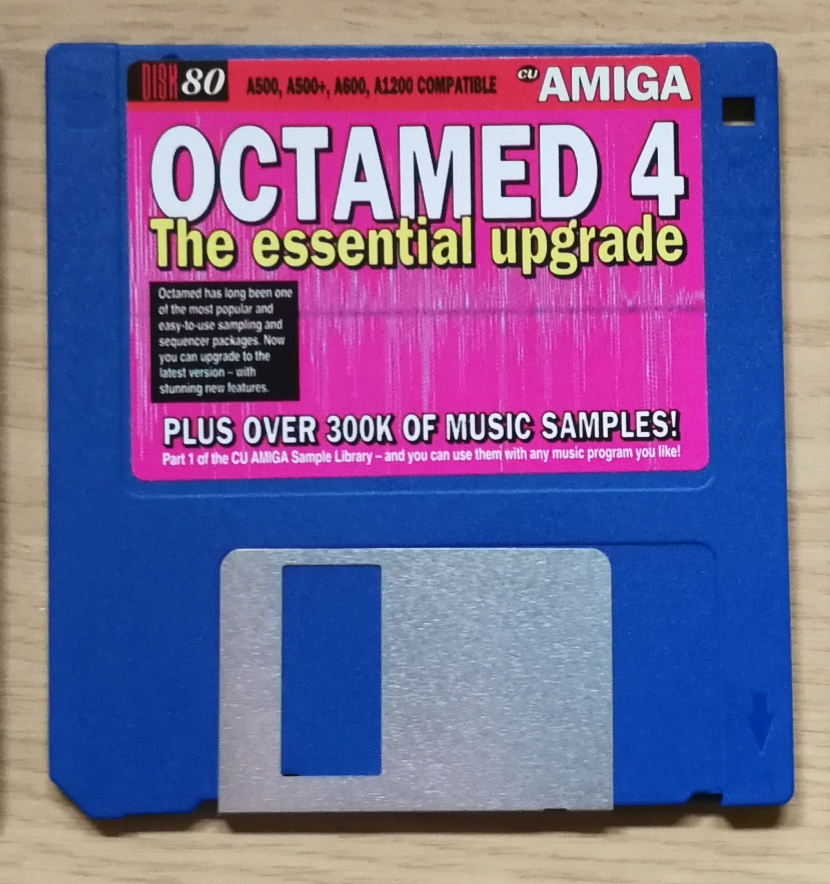 You can’t talk about the Amiga without talking about its music making abilities. A giant in the world of composing, the Amiga had a vast swath of products for producing music in just about any way you wanted.
You can’t talk about the Amiga without talking about its music making abilities. A giant in the world of composing, the Amiga had a vast swath of products for producing music in just about any way you wanted.
OctaMED is a package that owes a lot to its presence on the covers of printed media. Probably the most featured product on Amiga coverdisks full stop, OctaMED was many people’s first introduction to digital music creation, and many artists continue to use it today for its excellent splicing of tracker music with MIDI input. All three of the magazines I’ve been looking at here had MED or OctaMED on the cover at some point, from the very first version through to the final Amiga release, OctaMED Soundstudio. My particular favourite is OctaMED Pro v5 (AF62), which I fiddled around with for many a long evening in my childhood, much to the pain of my parents’ eardrums…
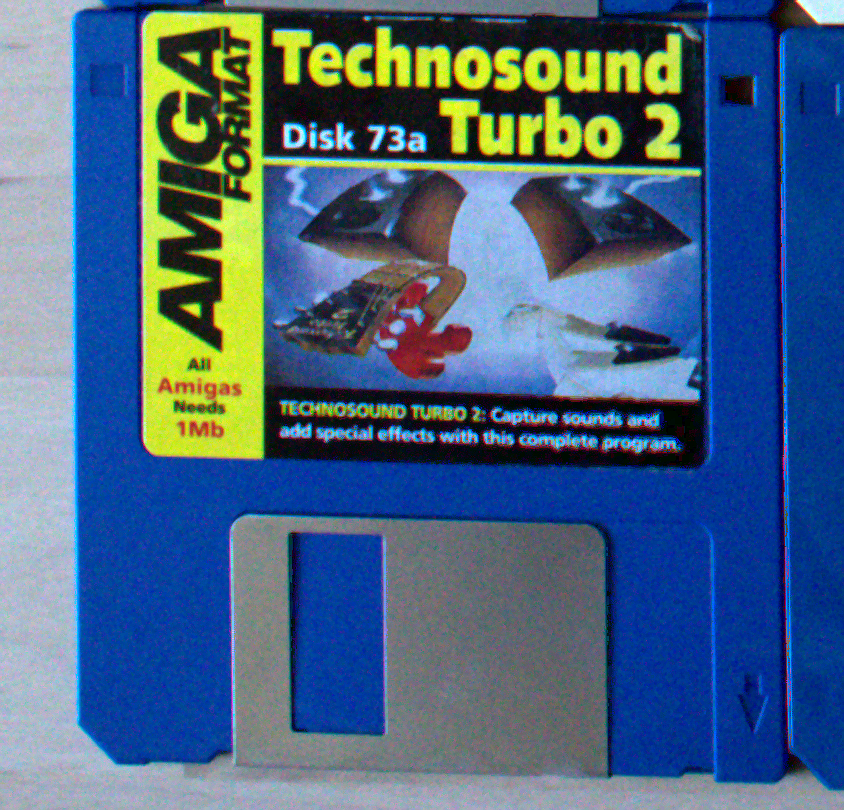 Trackers rely heavily on samples for their instruments of course, and while you can grab these from sample disks and from other mods, it was more common for people to rip those samples from records or through a microphone. Technosound Turbo 2 (AF73) was a popular sampler given away on a cover. The problem being, of course, that a sampler is more than just the software… so you were really just limited to sample editing with your new package. Luckily, developers had a special offer to allow readers to get the hardware sampler for just 20 quid. That’s how they get ya!
Trackers rely heavily on samples for their instruments of course, and while you can grab these from sample disks and from other mods, it was more common for people to rip those samples from records or through a microphone. Technosound Turbo 2 (AF73) was a popular sampler given away on a cover. The problem being, of course, that a sampler is more than just the software… so you were really just limited to sample editing with your new package. Luckily, developers had a special offer to allow readers to get the hardware sampler for just 20 quid. That’s how they get ya!
Maybe your musical education was a little more traditional? What you need is Bars & Pipes Professional, a MIDI sequencer given away on AF71. Now obviously, you can’t sequence MIDI particularly easily without some kind of MIDI device to play, and a MIDI interface to access it from your Amiga – so there’s some overhead here. But you’re still getting the software for free! The same was true of fellow sequencer Music-X (AF58) – both were serious pieces of software, and since MIDI remains a standard to this day, you can even use these pieces of software with modern music hardware too.
OctaMED on a coverdisk got me into music production. I think I did have MED first too. [ASNiVOR]
Soundtracker Pro II on an AF coverdisk really started me on my way to working with samples and sequences. [Paulee Alex Bow]
I released a couple of records made using OctaMED Soundstudio and other audio software given away on coverdisks. I also built my sample library primarily from all the modules and samples on coverdisks collected over the years. I think Tony Horgan is due most of the credit there. My day job is in networking and coverdisks also helped a lot with getting online in the early days. [Philip Kaulfuss]
Programming
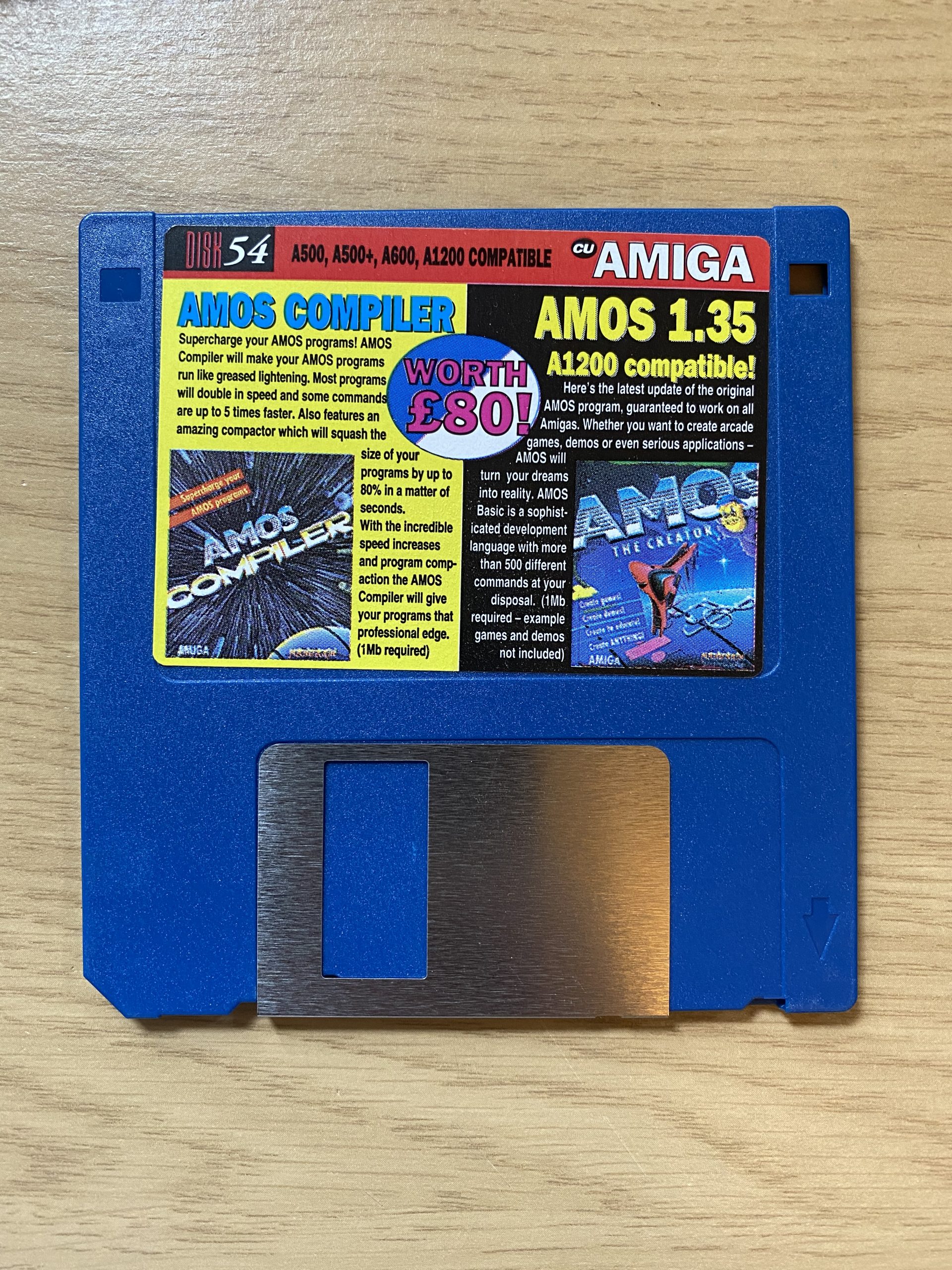
As someone who would later go on to study coding and work in development for many years, this topic is pretty close to my heart. I’d already meddled with BASIC on my ZX Spectrum, so getting into programming on my Amiga and developing my skills there was pretty much a given. And magazines helped out hugely here.
Whenever anyone mentions programming on the Amiga, you can be sure to hear one name whispered in hushed tones, and that’s François Lionet’s BASIC language, AMOS. While I am now the proud owner of a boxed copy of AMOS, I wasn’t back in the day – my copies of the package we all included on magazine covers. From the cut-down version for beginners, Easy AMOS (AC81), to the standard edition and compiler (AF42/CU April 93), through to fully fledged AMOS Professional (AF67) – there’s no excuse for not having the language, if only to tinker around with. I still have disks full of half-finished projects based on my ill-developed teenage coding skills!
If your 90s coding skills were a little more evolved than mine were, then a BASIC interpreted language probably isn’t going to cut it for you. In that case you’re probably going to need something a bit “closer to the metal”, and if the MOVs, PUSHs and POPs of Assembly language are more your speed, then you have a choice of environments to work with – ArgAsm (AF7) is perfectly capable, or you may want to use one of the various versions of Devpac 2 (AF39/AC76) to do your coding with.
Amiga E was on a coverdisk, and, along with PCQ Pascal, taught me ‘proper’ talking-to-the-OS programming. I’ve been a professional coder for (Jesus Christ, where does it go?) – 18 years now? Working in simulation of graphics HW mostly. Pretty low level, so all the bit fiddling on the C64 and ‘proper’ languages on the Amiga were very useful. [Two Owls]
Devpac 2 and AMOS on Amiga Format coverdisks gave me a 20 year career in software development… including porting some games to Amiga late in its life, the most notable being Simon the Sorcerer 2. [Peter Mulholland]
Well, I used Devpac and ArgAsm from cover discs and eventually bought DevPac. I think Devpac came with the Davy Jones Locker tutorial stuff (was it called that? How to make Blood Money basically)? Many, many, years later, I ended up a games programmer, eventually even working at Argonaut Games (who made ArgAsm in the first place) on PS1 games. The cover discs were super important to me because it took me ages to afford Devpac and the coding tutorials really helped me out. [ExUnit]
Further learning
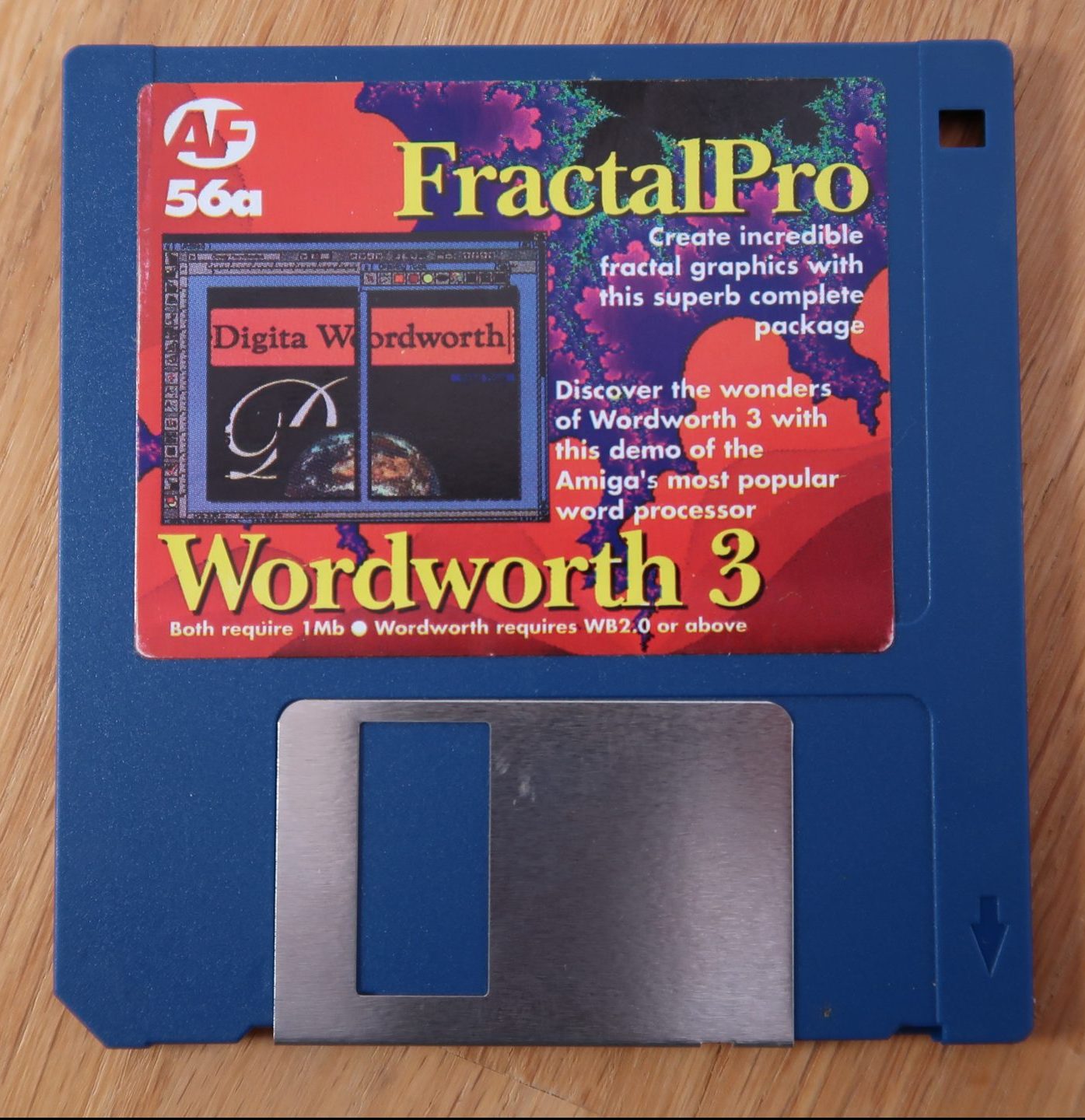 The Amiga could do so much, more than I could possibly cover here. Some things were incredibly specialist, but because of coverdisks, we got to have a go at all sorts – making fonts, playing with computer-generated music, making menus. Let’s look at a few things that might pique your interest.
The Amiga could do so much, more than I could possibly cover here. Some things were incredibly specialist, but because of coverdisks, we got to have a go at all sorts – making fonts, playing with computer-generated music, making menus. Let’s look at a few things that might pique your interest.
Firstly, I want to give a mention to fractal generator Fractal Pro (AF56). It’s pretty simple, but it holds a special place in my heart for being the coverdisk for my very first copy of Amiga Format. And come on, who doesn’t love infinitely zooming in on the Mandelbrot Set?
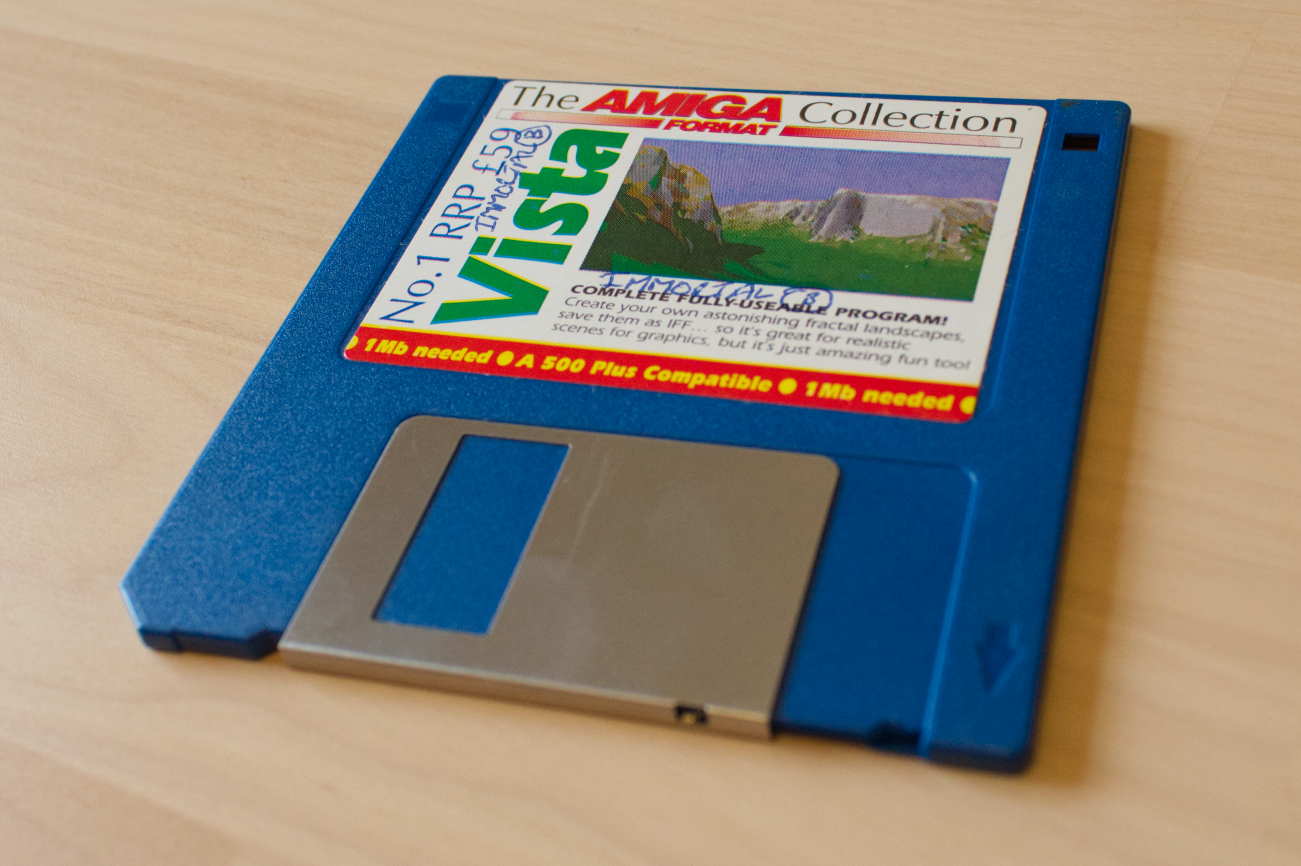 While we’re in the visual space, I should definitely give a mention to landscape generator Vista (and Vista Pro), from AF33 and CU September 97 respectively. Building a mountain or two is always fun!
While we’re in the visual space, I should definitely give a mention to landscape generator Vista (and Vista Pro), from AF33 and CU September 97 respectively. Building a mountain or two is always fun!
Scala (AF97, CU Feb 94/Feb 98) is quite a special piece of software – not only does it do video titling and interactive slide show presentations, you can also use Genlock hardware to overlay content over live video input. And this is another product that survives to this day – many digital signs and displays you see around the country and the world use Scala technology.
We like to think you enjoy our little magazine, but how do you think we got here? By learning how to do desktop publishing on the Amiga of course! And there’s no shortage of DTP packages to choose from: Gold Disk Inc.’s PageSetter is a really solid package that I used to do my homework back in the day – all albeit using a later version! CU Oct 95 had a copy of v2.2. And if all that isn’t enough, CU June 97 gave away a copy of ProPage 4.1. There’s some pretty good headlines in there, and that’s for sure!
thanks to AF63. Maybe you want to go more upmarket than that? Well, why not use PageStream? We did – to create this very page,
I’m sure we all spend a lot of time watching the latest demos, but what if you’re not a real coder, but still want to have a crack at making some scrollers and spinning shapes? Lucky for you then that magazines can provide – RSI Demo-Maker (CU Oct 91) and Demo Maniac (AF60) are both user-friendly pieces of software to build basic demos. You’re not going to win Revision, but you might have a bit of fun into the bargain!
But if you only ever get one application coverdisk, there can really only be one choice. The ultimate application for Amiga users. The only file manager you’ll ever need… for free! You know it. I know it. Grab your copy of CU Amiga February 95 – it’s Directory Opus 4.
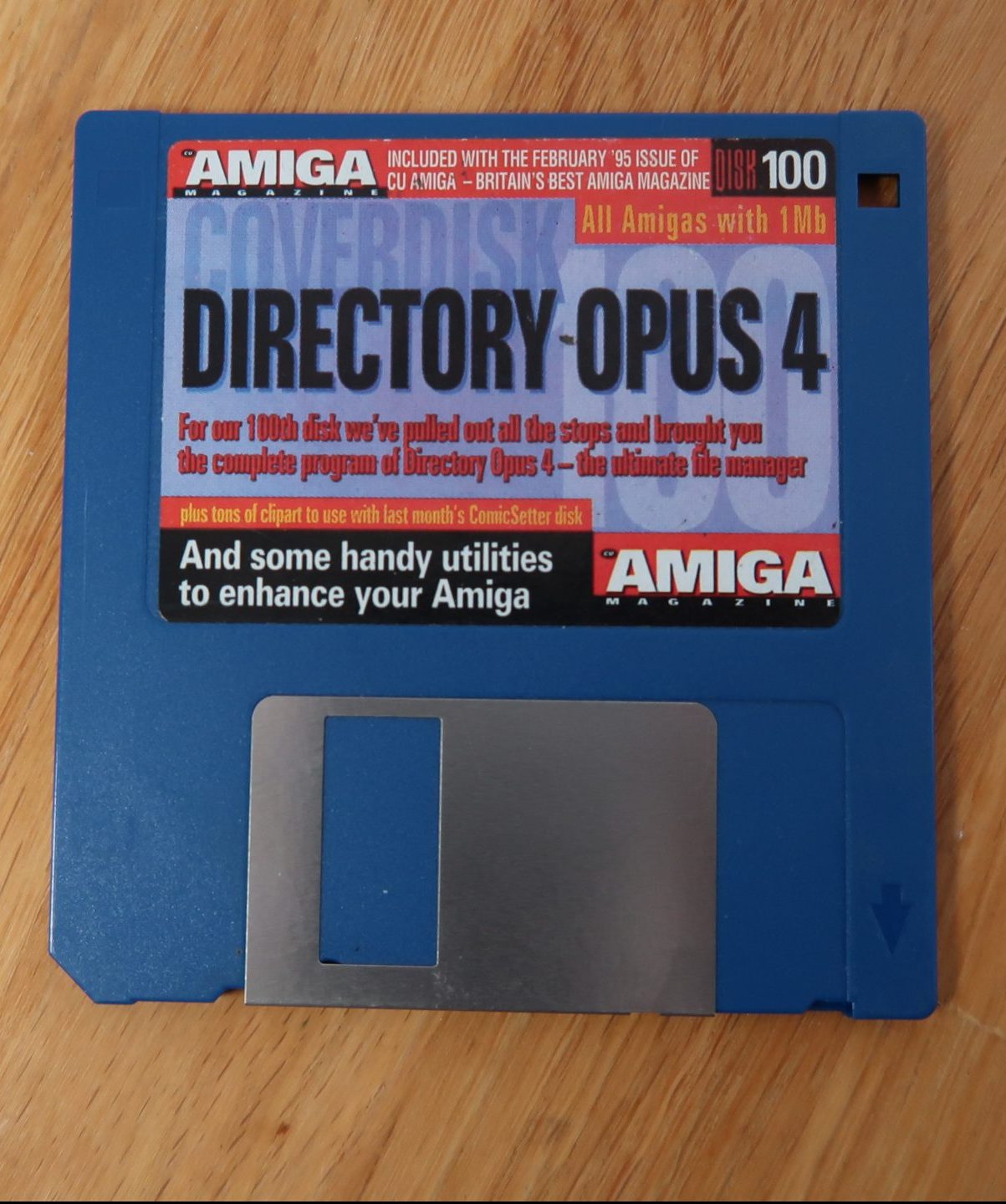
Conclusion
This article only scratches the surface of what magazine coverdisks truly enabled, whether it was just sparking Amiga users’ creativity, or exposing them to interests they never knew they had, at a budget price. And while it was really just in support of selling a few more magazines… if you have a hobby, or even a career, because of one of those little blue squares of plastic, maybe you want to say a silent “Thank you” to the disk editors and developers who made it possible. I know I will.
| This is a modified version of an article originally written for Amiga Addict magazine, and was published in Issue 6. You can get copies and subscriptions for the magazine over at the website www.amiga-addict.com |

